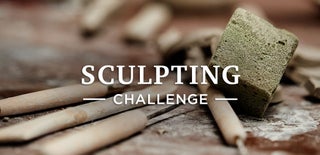Introduction: Ceramic Sunflower
I am so excited to share with all of you one of my favorite projects. I made this in a first year ceramic class and am very pleased with the result. This was probably my most time consuming project of the semester, but I had so much fun with it that it didn't seem like work at all. During that time, working on it was the highlight of my day; I can't wait to share the process.
Supplies
Low Fire Cone 06 White Clay
Plastic Wrap
Precision Knife
Rolling pin
Wet Sponge
Ball Stylus Sculpture Tool
Amaco Artist's Choice Lead-Free Glaze - Print - Camel
Score and Slip (metal brush used to scratch the surface of the clay and a mixture of clay and water used to act like glue)
Spray Bottle
Sand Paper
Bamboo Brush
Step 1: Creating the Center
To begin the process, first decide how large you desire the end product to be. Take a chunk of clay that is about the correct size and begin rolling it out flat with a rolling pin. Once you have rolled it to be the desired thickness (mine was about a quarter of an inch), use the precision knife to cut the piece into a circle. My center ended up being about 12 inches in diameter.
After you have the circle prepared, use the sponge to smooth the surface. Once smooth, begin to carve the seed-like design into the surface. The indents created should be deep enough that if you were to run your finger over them with your eyes closed, you would know where they were. This is important because later, if they are too shallow, the glaze will end up filling them and they will not be noticeable.
Side Note: If you pause work on the project for a span of time longer than an hour or two, take a spray bottle and spray down the project and then cover it (air-tight) with plastic wrap. Clay dries out quickly,and if it dries too much it is difficult to work with.
Step 2: Adding Petals
To begin this step, take a ball of clay and begin rolling pieces of it into cords about three quarters of an inch thick and 6 inches long. If your project is the same size as mine, you will need 16 of these cords to successfully cover the edge of circle.
After creating the cords, take your center and score and slip (see supplies if this is unfamiliar) it to prepare for the attachment of the cords. Next, take one cord and press one of the ends onto the circle's edge. Then take the other end and attach it right next to the first. Continue this process until all the cords are attached and the whole border of the circle has what appears to be "loops" on it.
Where the cords' ends are attached there will be a small line in-between. Press down on the ends, adding slip if necessary, to make them appear as one. Once that is done, the petals are almost complete. The issue remaining is that the petals are still loop-shaped. To fix this, pinch the tops of the loops to force the clay into a petal shape.
Sometimes the circle will show through the center of the petal if it was attached too far in. This can be fixed by taking the precision knife and cutting out the part that is showing.
Finish by smoothing out any bumps of nicks with the sponge.
Step 3: Fire and Glaze
Before glazing, the clay project must be placed in the kiln and set to fire. This first firing is known as the "bisque fire" and takes place before any glaze is applied. After it is fired, the clay will have a white appearance. The photo I attached is of the flower after I glazed it.
Before glazing, if there are any rough edges that you just now notice, sand paper can be used to smooth them out.
To glaze, begin by taking the container of Camel glaze and shaking it thoroughly for 1-2 minutes. This will insure that the glaze is properly mixed before it is applied.
To apply the glaze, I chose to use a bamboo brush, but most types will work. Bamboo brushes are my preferred choice as they always seem to hold the glaze well which makes for easy application.
Apply a minimum of 2 coats of the glaze over the surface of the project. Avoid stroking the brush in just one direction- this could result in a streaky look.
When applying the layers make sure to let one layer fully dry before adding the next one. This will make the glaze look more evenly applied.
After having finished glazing, place the flower in the kiln for the "glaze fire". This is the last step of the process. After the fire is complete, you will open the kiln and see the finished product!
Step 4: Finished Product!
After all the steps are complete, you can enjoy the finished product. Opening the kiln and seeing it finished is the perfect reward for all the effort put forth over the last week or two. In my opinion, one of the best parts is getting to see how the glaze has changed after firing. Camel glaze is truly beautiful when it's finished.

Participated in the
Sculpting Challenge







